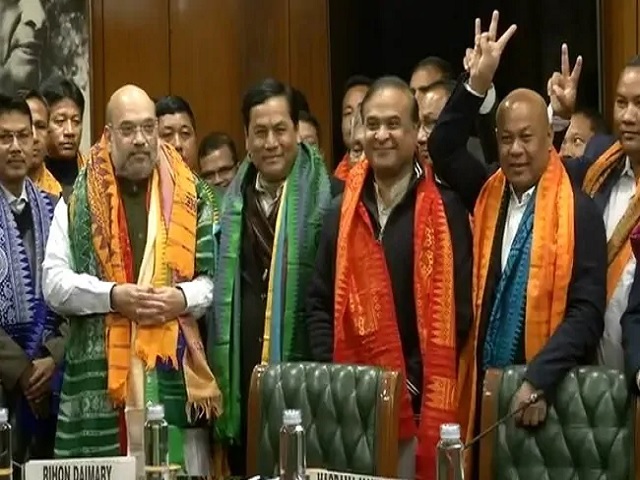
Picture : Twitter / ANI
The conclusion of the Third Bodo Peace Accord on 27 January last with the signing of a Memorandum of Settlement between the Centre , Government of Assam and all factions of the National Democratic Front of Bodoland – the insurgent group spearheading the demand for a separate Bodoland State is indeed a watershed in the troubled narrative of West Assam. And the surrender of arms by the National Democratic Front of Bodoland and other Bodo , Adivasi and other non Bodo armed groups therafter on 30 January will go down in history as yet another bold initiative of the Prime Minister Narendra Modi to restore peace and development process in West Assam after decades of Bodo insurgency and conflicts that claimed over 4000 lives and destabilized the entire Brahmaputra valley.
Though Bodo identity politics began in 1968 with the formation of the Plains tribals council of Action the militancy began in 1987 as a section of the Bodos thought that time was opportune after the 1985 Assam Accord to stake their claim for a homeland as among the” original inhabitants” of the Brahmaputra valley. There were however several practical difficulties; first, the Bodos were a scattered tribe sharing the valley land with all other groups practicing the same type of seasonal agriculture as others ; second ,they were in various stages of assimilation with other neighboring ethnic groups and though listed in the Schedule of PlainsTribes as Bodo Kachari ,the Bodos living in the hills were not notified as a tribe in Hill Districts like Karbi Anglong or NC Hills presumably because of their advanced agriculture, trading of surplus produce and ways of life being close to other settled Assamese and other ethnic groups of the Plains. Thus the areas inhabited by the Bodos were not notified as ” tribal areas” either under the Scheduled Districts Act 1874 nor under the Government of India Act 1935 as” Excluded” or “Partially Excluded”areas. It may be recalled that the Sixth schedule as originally enacted under the Constitution covered only the Excluded and Partially excluded areas of the hill areas of Assam and not other tribal areas. The Bodos therefore didn’t enjoy autonomy as the Hill tribes of Assam. They were granted only some protection of their” land rights” after Independence with the incorporation of Chapter 10 in the Assam Land Revenue Regulation 1886 which set up “Tribal Belts and Blocks” in the Districts they inhabited. The protection was inadequate as the alienation of tribal lands continued. This feeling of being marginalized as compared to the hill tribes after creation of the Hill states in 1971 fueled the Bodo demand for a separate state.
To appreciate the wider ramifications of of the Bodo Kachari movement we may note that the Bodos are also a Scheduled tribe notified as Mech in West Bengal and spread across the entire Teesta Brahmaputra basin covering Assam, North Bengal and north Bangladesh. Anthropologists like Endle found similarities between the Koch, Bodos,Rabhas and even Garos living in the north east. Possibly it is the degree of what sociologist M.N.Srinivas called ” Sanskritization” that set apart the Koch Rajbanshis of North Bengal and Assam from the Bodos. However the distinct linguistic identity of the Bodos was recognized . In the Gazetteer of Bengal and north east India authored by BCAllen et al it was noted as per 1901 census 18% of the population of old Goalpara District which was transferred from Bengal to Assam spoke” Bodo or Plains Kachari language which over the years became the official term to define the Bodos all over the Brahmaputra valley which encompassed related groups like the Sonowal Kacharis of upper Assam. Thus the anthropologists see Bodos as not much different from Rabhas or Koch Rajbanshis and integral to the cultures and societies of North Bengal and Assam wherever they live. The ongoing movement- also violent for a separate Kamtapur state launched by Kamtapur Liberation Army and sections of the Koch Rajbanshis in North Bengal and adjacent parts of Assam might as well appear as a counter to the Bodoland in this region of competitive ” identity assertion”. The reported decision of Assam to set up yet another Autonomous council for the Koch Rajbanshis in this very area has added a new complexity to the identity politics of West Assam. Equally significant is the fact that the assorted groups of militants who surrendered on January 30 last included the Koch Rajbanshis, Adivasis and others representing all ethnic groups which means that the political society of Bodoland is a severely fractured one. More than resettlement of 1615 surrendered NDFB militants it is necessary to restore the confidence of all living in Bodoland in the fairness and justice of the new structure of local government – Bodoland Territorial Region even when it will be dominated by the Bodos forming only about 27% of the population.
It must be noted that though the new Accord provides for “alteration of the area under the present Bodoland Territorial Administrative District” for which a commission will be appointed by the government of Assam, its recommendations are unlikely to either alter the boundaries significantly or change the population pattern of the four Districts which constitute BTAD now. Anticipating this reality the Accord provides for setting up of a Bodo Kachari welfare council for development of Bodo villages outside Bodoland. The other stipulation that Bodos in the Karbi Anglong and Dimahasao Hill Districts will be notified as scheduled tribes is bound to be contentious as it will put the Bodos in the power structure reducing thereby the power of the entrenched tribes of the Karbi Anglong and Dimahasao Autonomous District Councils.
The more important aspects of the Accord are however the enhanced legislative, administrative and financial powers and the Centre’s commitment to provide a Rs 1500 crore development package to Bodoland Territorial Region and establishment of high profile central institutions in education, health and skill development and physical infrastructure. This is line with the Centre’s policy to upgrade the infrastructure in the North East and has been well received.
The change from BTAD to Bodoland Territorial ” Region ” as a council under the sixth Schedule with more powers and functions than allowed under the 2003 Accord implies an upgradation of its status from a District to a Region which is much like the status granted to Meghalaya when it was first made a substate within Assam in 1969. In a way the Accord has also brought about a major though unstated change in the role of Assam as it has now (a) an autonomous” Region” – BTR and (b) 2 Autonomous District Councils in Karbi Anglong and Dimahasao Districts under the sixth Schedule and (c) 7 autonomous councils under the state laws which is unique in the country and makes Assam a federating state accommodating diverse Regions – Hills, Barak valley Districts and distinct ethnic groups. This demands a broad-minded, liberal and democratic leadership both at the state and at all these” local self government” levels capable of managing affairs in a just and fair manner to bring about unity, peace and all round progress. This is more true of Bodoland Territorial Region because the Bodos will enjoy effective power in the BTR by virtue of the majority of the seats in the Council despite their low share of the population which is unlikely to change significantly even if some Bodo majority villages are added to the BTR as envisaged in the Jan 27 Accord. To put it bluntly the BTR cannot be run as a ” tribal state” promoting only ” tribal interest” for the simple reason that given the high proportion of the ethno lingual groups other than the Bodos in BTR and the militancy amply demonstrated by the Adivasis and others in pressing their rights as citizens reconciliation and not bulldozing their demands is the only way for the Bodo leadership to make BTR and the development package that the Prime Minister Narendra Modi has provided work for all round progress of Bodoland. Further, the way market economy of any area functions,it binds all ethnic groups there is no other way for BTR but to follow the PM Modi’s call – “Sab ka Sath sabka Vikas” meaning all stakeholders moving together towards progress. And this holds good for all the 7 North East states as well. The success would depend entirely on how the Bodo leadership exercise the expanded power and responsibilities to build a new cohesive Bodoland founded on inclusive growth covering all ethnic groups. This alone could justify the bold decision of the centre to extend Sixth Schedule to the 4 Plains Districts of deviating from the principle of restricting Sixth Schedule system of autonomous tribal governance only to Hill areas of Assam as it was constituted in which the tribes constituted overwhelming majority of the population and hence deserved protection. J. B. Bhattacharjee, distinguished historian and former VC Assam University Silchar pointed out that the real object of incorporation of the Sixth Schedule in the Constitution was to maintain the integrity of Assam.
However even after reorganization of Assam in 1971and separation of 3 sixth Schedule areas which now form Meghalaya and Mizoram, Assam has two sixth Schedule Hill Districts- Karbi Anglong and Dimahasao ; and together with the 4 Districts- Kokrajhar,Chirang, Udalguri and Baksa under the BTR, these areas are so strategically placed that separation of any of these from Assam will render Assam unviable because of loss of physical connectivity to all parts.
Herein lies the historic importance of the 27 January Bodo settlement and the imperative need to usher in unity and reconciliation in Bodoland’s complex ethnography. BTR is after all a ” local self governing body” and such entities work only when all Tax/ Rate payers are treated as equal stakeholders. After all the idea of democracy is founded on this premise.
[the_ad id=”22718″]


















